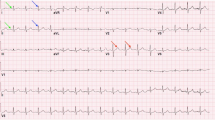Abstract
Blind source separation (BSS) is an important analysis tool in various signal processing applications like image, speech or medical signal analysis. The most popular BSS solutions have been developed for independent component analysis (ICA) with identically and independently distributed (iid) observation vectors. In many BSS applications the assumption on iid observations is not realistic, however, as the data are often an observed time series with temporal correlation and even nonstationarity. In this paper, some BSS methods for time series with nonstationary variances are discussed. We also suggest ways to robustify these methods and illustrate their performance in a simulation study.
Similar content being viewed by others
References
Belouchrani A, Abed-Meraim K, Cardoso JF, Moulines E (1997) A blind source separation technique using second-order statistics. IEEE Trans Signal Process 45: 434–444
Cardoso JF (1989) Sources separation using higher moments. In: Proceedings of the 2000 IEEE International conference on Acoustics, Speech and Signal Processing, pp 2109–2112
Cardoso JF, Souloumiac A (1993) Blind beamforming for non Gaussian signals. IEE Proc F 140: 362–370
Choi S, Cichocki A (2000a) Blind separation of nonstationary sources in noisy mixtures. Electron Lett 36: 848–849
Choi S, Cichocki A (2000b) Blind separation of nonstationary and temporally correlated sources from noisy mixtures. In: Proceedings of the 2000 IEEE Signal Processing Society Workshop Neural Networks for Signal Processing X, vol 1, pp 405–414
Choi S, Cichocki A, Belouchrani A (2001) Blind separation of second-order nonstationary and temporally colored sources. In Proceedings of the 11th IEEE Signal Processing Workshop on Statistical Signal Processing, pp 444–447
Cichocki A, Amari S (2002) Adaptive blind signal and image processing: learning algorithms and applications. Wiley, Cichester
Jutten C (2010) Handbook of blind source separation. Independent component analysis and applications. Academic Press, Amsterdam
Hettmansperger TP, Randles RH (2002) A practical affine equivariant multivariate median. Biometrika 89: 851–860
Hyvärinen A, Karhunen J, Oja E (2001) Independent component analysis. Wiley, New York
Ilmonen P, Nordhausen K, Oja H, Ollila E (2010) A new performance index for ICA: properties, computation and asymptotic analysis. In: Vigneron V, Zarzoso V, Moreau E, Gribonval R, Vincent E (eds) Latent variable analysis and signal separation. Springer, Heidelberg, pp 229–236
Maronna RA, Martin RD, Yohai, VJ (2006) Robust statistics. Theorey and methods. Wiley, Cichester
Matsuoka K, Ohya M, Kawamoto M (1995) A neural net for blind separation of nonstationary signals. Neural Netw 8: 411–419
Miettinen J, Nordhausen K, Oja H, Taskinen S (2012a) Statistical properties of a blind source separation estimator for stationary time series. Stat Probab Lett 82: 1865–1873
Miettinen J, Nordhausen K, Oja H, Taskinen S (2012b) Deflation-based separation of uncorrelated stationary time series (submitted)
Nordhausen K, Oja H, Tyler DE (2008) Tools for exploring multivariate data: the package ICS. J Stat Softw 28: 1–31
Nordhausen K, Ollila E, Oja H (2011) On the performance indices of ICA and blind source separation. In: Proceedings of 2011 IEEE 12th International Workshop on Signal Processing Advances in Wireless Communications (SPAWC 2011), pp 486–490
Nordhausen K, Cardoso J-F, Miettinen J, Oja H, Ollila E, Taskinen, S (2012). JADE: JADE and other BSS methods as well as some BSS performance criteria. R package version 1.1-0
Nordhausen K, Sirkiä, Oja H, Tyler DE (2012) ICSNP: tools for multivariate nonparametrics. R package version 1.0-8.
Oja H, Sirkiä S, Eriksson J (2006) Scatter matrices and independent component analysis. Austrian J Stat 35: 175–189
Pham D-T (2002) Exploiting source non stationary and coloration in blind source separation. In: Proceedings of 14th International Conference on Digital Signal Processing, pp 151–154
Pham D-T, Cardoso J-F (2001) Blind Separation of instantaneous mixtures of nonstationary sources. IEEE Trans Signal Process 49: 1837–1848
R Development Core Team (2011) R: a language and environment for statistical computing. R Foundation for Statistical Computing. Vienna, Austria
Tanaka A, Imai H, Miyakoshi M (2006) Theoretical foundations of second-order-statistics-based blind surce separation for non-stationary sources. In: Proceedings of the 2006 IEEE International Conference on on Acoustics, Speech and Signal Processing. ICASSP 2006, pp 600–603
Theis FJ, Inouye Y (2006) On the use of joint diagonalization in blind signal processing. In: Proceedings of the 2006 IEEE International Symposium on Circuits and Systems, ISCAS 2006, pp 3586–3589
Theis FJ, Müller N, Plant C, Böhm C (2010) Robust second-order source separation identifies experimental responses in biomedical imaging. In: Vigneron V, Zarzoso V, Moreau E, Gribonval R, Vincent E (eds) Latent variable analysis and signal separation.. Springer, Heidelberg, pp 466–473
Tong L, Soon VC, Huang YF, Liu R (1990) AMUSE: a new blind identification algorithm. In: Proceedings of IEEE International Symposium on Circuits and Systems, pp 1784–1787
Würtz D, Chalabi Y with contribution from Miklovic M, Boudt C, Chausse P and others (2009) fGarch: Rmetrics-Autoregressive Conditional Heteroskedastic Modelling. R package version 2110.80
Yeredor A (2010) Second-order methods based on color. In: Comon P, Jutten C (eds) Handbook of blind source separation.. Independent component analysis and applications. Academic Press, Amsterdam, pp 227–279
Author information
Authors and Affiliations
Corresponding author
Rights and permissions
About this article
Cite this article
Nordhausen, K. On robustifying some second order blind source separation methods for nonstationary time series. Stat Papers 55, 141–156 (2014). https://doi.org/10.1007/s00362-012-0487-5
Received:
Revised:
Published:
Issue Date:
DOI: https://doi.org/10.1007/s00362-012-0487-5




